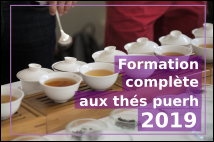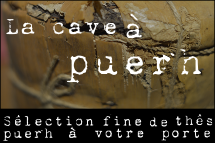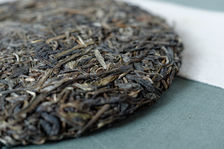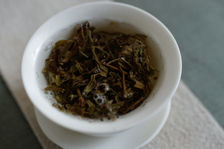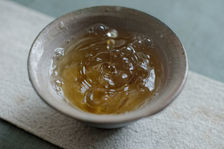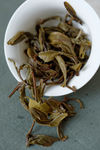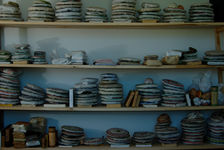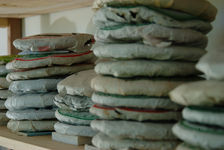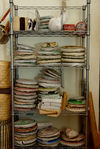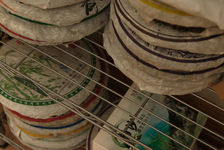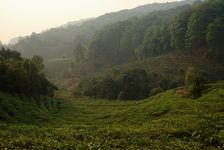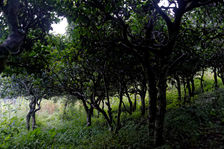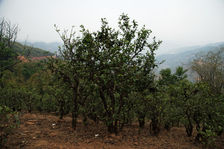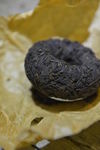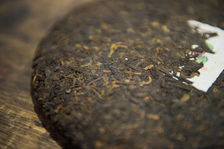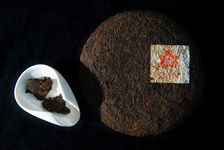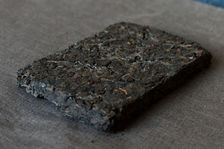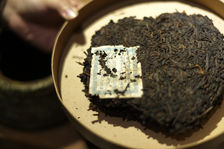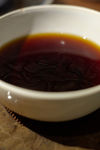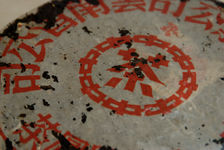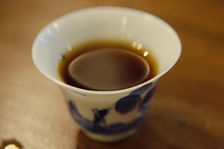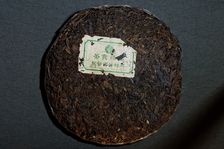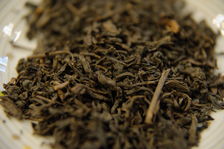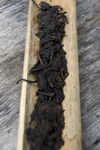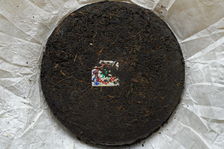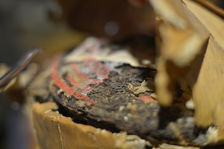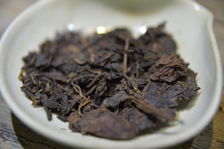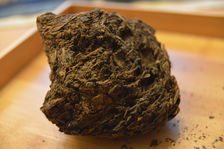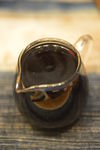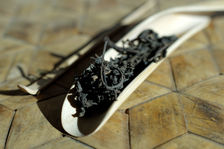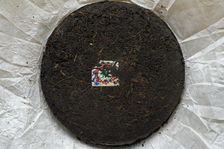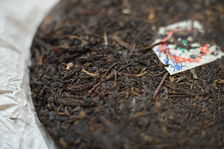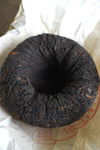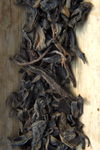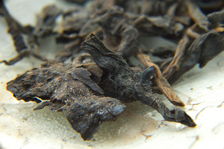 This page is not a real translation but just an automatic translation generated by computer of the original article, written in French language! Its not good... but better than nothing!
This page is not a real translation but just an automatic translation generated by computer of the original article, written in French language! Its not good... but better than nothing!Want to help us do diffuse puerh tea culture in english, by providing a better (or corrected) translation?
Please contact us!

The puerh (Pu Er tea) is one of the largest and most diverse tea families. Situated at the crossroads of different cultures, it has gradually been defined by History. The puerh (Pu Er tea) thus encompass today teas of a radically different nature ranging from ultra-fresh green tea that is consumed immediately after its production, to dark teas, to teas more or less old, marked by time, fermented Or refined in different ways.




- 1.Feuilles de jeune puerh (Pu Er tea) vert infusées
- 2.Galette de jeune puerh (Pu Er tea) vert
- 3.Puerh mature de 60 ans
- 4.Puerh mature de 50 ans
Faced with this diversity and the multitude of regions, vintages, producers and appellations (often misleading), the neophyte may feel lost, and does not know which tea to orient. In order to try to see more clearly, we propose here and there many classification according to the initial fermentation of the tea ( sheng cha, shu cha ), its origin ( Village, etc. ), its age ( 2000s, 90s, 80s, etc. ), the nature of the trees ( Ye Sheng, Gu Shu, Qiao Mu, Xiao Shu , Tai Di, etc. ), of the age of these trees, often estimated in a very fanciful way ( 400 years, 800 years, more than 1000 years Based on the shape of the product or on its weight ( 100g, 357g, 400g ), and so on.
While these categorizations make sense for the experienced expert or amateur, they sometimes do not help the one who discovers puerh (Pu Er tea) tea and seeks to perceive or understand its main orientations.



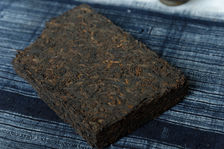
- 1.Thé puerh (Pu Er tea) compressé en galette
- 2.Thé puerh (Pu Er tea) compressé en tuo
- 3.Thé puerh (Pu Er tea) compressé en jincha
- 4.Thé puerh (Pu Er tea) compressé en brique
To make a parallel, to classify its library by the origin of the authors of the works it contains, by their political inclinations, or by the number of pages of these books might be interesting, such a rapprochement making a sense emerge, But it will be agreed that such a library might not help much who discovers literature and seeks great landmarks!
Thus certain attempts at categorization lose more than they help the one who discovers puerh (Pu Er tea) tea, and end up bringing up questions and contradictions:
Is the tuocha a type of puerh, and has it a taste characteristic of its own? Why are the "sheng cha" of the 90s so dark, is it because of their age? What do we mean by old tea and what is expected of an old tea:is a 10 year old tea an old puerh? If I keep 20 years a tea of the year, can it approach a tea produced in the 90? Is it correct to speak of vintages in the puerh, and if so, does this vintage matter, or only the age of tea? If I store my tea in a humid place, is it a "wet storage"? Is a darker tea still older? Is a young puerh (Pu Er tea) green part of the family rank of "theś sombres"? Etc ...
The aim of this article is therefore to come back to something more clear, simple and above all bearer of meaning, by presenting to you the great families of puerh (Pu Er tea) teas as they are defined in the course of history, Both by the specific culture in which they are inscribed, but also and above all by a clearly identifiable gustatory character that defines them. Thus the universe of the puerh (Pu Er tea) could be summed up in four main families:
- Green puerh, or young raw puerh (Pu Er tea) (sheng cha)
- Shu cha, or modern fermented puerh (Pu Er tea)
- The old puerh (Pu Er tea) (50 years and over)
- Traditional Hong Kong, or puerh (Pu Er tea) refined storage
Green puerh (Pu Er tea) (or young raw puerh)
Also called raw puerh, or sheng cha, these are teas produced after the early 1990s, unfermented or slightly fermented naturally. It is the oldest form in which puerh (Pu Er tea) tea has been consumed for several centuries in the golden triangle region (Yunnan, Burma, Laos, Thailand, Viet Nam). Although this form is the original form of puerh (Pu Er tea) tea, it has only been about fifteen years that this tea is consumed in this way outside the countryside where it is produced. Indeed, the great puerh-amateur regions that have made the reputation of this tea, such as Hong Kong, Taiwan or Malaysia, have always consumed puerh (Pu Er tea) after fermentation (whatever its type), until the Great re-discovery of puerh (Pu Er tea) tea in the 90's.
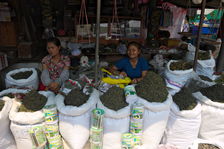
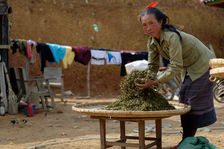
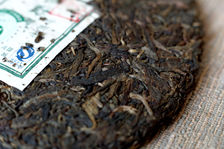
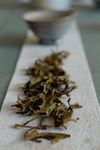
- 1.Puerh vert sur un marché en Birmanie
- 2.Production du puerh (Pu Er tea) vert au Laos
- 3.Galette de puerh (Pu Er tea) vert dans le Yunnan
- 4.Feuille de puerh (Pu Er tea) vert après infusion
If the green puerh (Pu Er tea) is very old, its nature has changed a lot since the 90s to become increasingly green and less tannic in order to adapt to palates sensitive, especially urban, and to be able to be Consumed and appreciated as green tea and from its production.
By nature, this tea is closer to the family of green teas than to that of dark teas in which the puerh (Pu Er tea) are generally classified (for historical reasons). However, they are distinguished from green teas by a slight oxidation, more or less pronounced, as well as a more or less pronounced natural fermentation (depending mainly on their age) as well as a potential to preserve and evolve with the years. Their leaves are dark green, which clears up during infusion, and gradually turn green brown over the years. The liquor produced varies from a pale yellow, almost transparent to some teas, to a deep orange, depending on the age of the tea and its rate of oxidation.
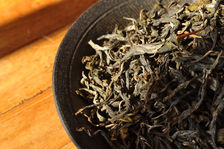

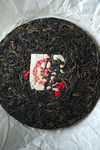
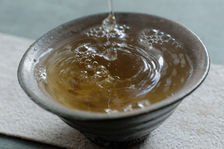
- 1.Puerh vert en vrac Copyright Sébastien Vacuithé
- 2.Feuilles infusées d un jeune puerh
- 3.Puerh vert de quelques années en galette
- 4.Liqueur d'un jeune puerh (Pu Er tea) vert
The green puerh (Pu Er tea) are therefore teas that are appreciated today young, for the quality of their fresh character, in the year of their production (see puerh (Pu Er tea) primeur ), or after a few years of maturation. Over time, vegetal and youthful spices will gradually give way to secondary flavors produced by oxidation and fermentation. Some of these (increasingly rare) teas have the potential to improve over the long term and can be preserved over several decades and gradually become old puerh.
Taste character
The green puerh (Pu Er tea) express themselves through their freshness, in the manner of little oxidized teas (green teas, wulong, etc.). In the year following their production (primeur) they present a floral and vegetal bouquet, sometimes accompanied by spicy touches.
Many puerh (Pu Er tea) greens now have a particularly rapid maturation, and at the same time have low long-term retention potential. These teas are especially appreciable in primeur or after a few years of maturation. They will develop aromas less vegetal and more fruity, candied or honeyed.
The green puerh (Pu Er tea) that possess a real potential of conservation, more tannic, powerful and produced in the manner of the teas of the past, will generally develop over the years a wooded dimension and typical touches of fresh wood that can recall the camphor wood or the " eucalyptus. These teas, when they are 10 to 15 years old, can be particularly strong, tannic and very focused on the camphoric dimension, which is due both to the nature of the teas produced at that time, and to their transformation Over fifteen years.
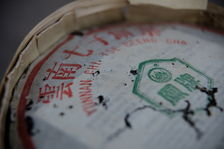
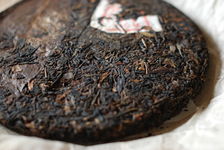
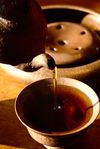
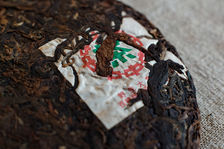
- 1.Galette de puerh (Pu Er tea) vert de 1996
- 2.Puerh de garde de 2005
- 3.Liqueur d'un puerh (Pu Er tea) vert de 10 ans
- 4.Puerh de garde de 2000
Most of this puerh (Pu Er tea) family
- Compared to green tea, young puerh (Pu Er tea) generally allow a much higher number of infusions (often more than 10 successive infusions), and offer more changes from one infusion to another. The slight oxidation, as well as the natural fermentation of the tea, also give young raw puerh (Pu Er tea) a less vegetable and more worked touch than is generally expected of a green tea.
- The large production area of puerh tea (golden triangle), the recent refinement of the terroir concept within this zone, whether in Yunnan (Lincang, Pu'Er, Banna) or (Laos, Thailand, Burma, Vietnam), as well as recent recognition of the variety of trees (Young trees, old trees, wild trees, etc.) gives this family of puerh (Pu Er tea) a very great taste diversity. There are thus very different characters, with very soft teas as well as dry and tannic teas, but also teas which can present vegetable, floral, spicy aromas, dominated by fruit wall or honey, citrus or even Marked by fine aromas of eucalyptus and camphor!
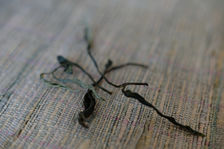
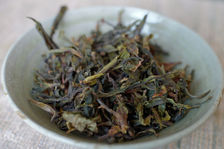
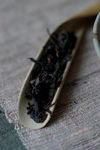
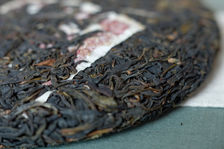
- 1.Feuille de jeune puerh (Pu Er tea) de Yi Wu
- 2.Feuilles de théiers sauvages
- 3.Théier sauvage de 10 ans d'âge
- 4.Feuille de théiers violets
- Although teas from certain recognized villages have become expensive in recent years, the price of puerh-green youth remains globally very accessible, whether in relation to ancient puerh (Pu Er tea) or other great Chinese teas.
- While a green tea, and a lot of green wulong, lose the bulk of their gustative richness in the year following their production, and must therefore be consumed quickly, a green puerh (Pu Er tea) keeps perfectly several years in contact with the air.
- Young puerh (Pu Er tea) greens change with time. Their flavors and their gustatory characteristics thus change gradually from year to year, offering the amateur not only a wide taste choice according to the age of the tea but also the pleasure of seeing his own teas evolve a year on the 'other.
The least of this puerh (Pu Er tea) family
- Some puerh (Pu Er tea) greens, especially when they come from old trees or are transformed in the old way, may present a bitterness or astringency that can disturb sensitive palates, especially for those who discover this family of tea . It is however possible to adapt the way to infuse these teas (shorter infusion time, more temperate water, etc.) in order to soften these teas.
- Contrary to what is sometimes heard, not all puerh (Pu Er tea) greens have the potential to improve with age, or should ideally be consumed within a given period of time, and it is advisable to take precautions before Store it in quantities.
How to choose a green puerh (Pu Er tea)
Young puerh (Pu Er tea) greens are usually produced today for immediate consumption. Choosing one of its teas for immediate consumption is therefore simple enough and you can rely on your own taste, by buying for example small quantities, in order to find the aromas that suit you best.
These teas come from mature trees (also called large trees, old trees, quiao mu, gu shu, etc.), are generally richer and more complex (aromatic complexity, returns, length in the mouth, etc.) and l The amateur of young puerh (Pu Er tea) green will therefore prefer this type of trees compared to teas from terraced crops (bushes).
However, the teas of old trees, which are more expensive to buy, are more complex and deep but also often more tannic (bitter, astringent). Thus, those who prefer softer and round teas will have an interest in orienting themselves, at least initially, to younger trees, but derived from non-intensive plantations. These teas, rounder and cheaper than the productions of old trees, can also be of very good quality.
The character of a young puerh (Pu Er tea) green changing quickly with time, one will choose the age of the tea according to the character sought. Teas of the year will be favored if we look for the vegetable dimension, floral or spicy, or teas of a few years if we prefer characters more fruity or light touches of honey. Those who prefer aromas more worn on the walls, cooked or compote fruits will turn more towards teas to the maturation fast and aged of several years more. Finally, the amateur of woody aromas, camphor freshness and touches of eucalyptus will opt for a tea of guard, with slow maturation, and already at least 10 years old.
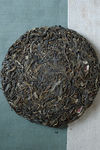
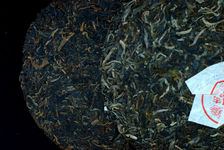
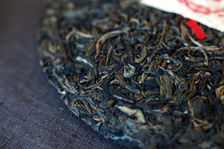
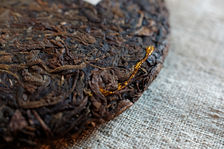
- 1.Puerh de l'année
- 2.Puerh vert d'age différents
- 3.Puerh vert de quelques années
- 4.Puerh vert de 15 ans
The choice of a guard puerh (Pu Er tea) in the perspective of a long maturation is on the other hand more complex and requires a certain understanding of puerh (Pu Er tea) and maturation (see What tea store ). It is not advisable to buy this type of puerh (Pu Er tea) in quantity without having already some experiences in the puerh (Pu Er tea) and its aging. Beware especially of the sellers for whom very often all the puerh, and in particular the most expensive, will improve with age, when it is far from being systematically the case. It is therefore preferable, before purchasing a tea to make it grow old, to inform oneself beforehand, to follow formations, to take part in tastings of old teas, and to train its palate to the different characters that constitute a guard puerh (Pu Er tea) and To their evolution over time.
Tasting of two green puerh (Pu Er tea)
To illustrate this family of puerh, I propose you the tasting of two green puerh. The first is a very young green puerh (Pu Er tea) of high quality, produced from old trees and reflects well what this type of crop can offer to the palate. The second is a 10-year-old puerh, produced in a very classic way in the image of older puerh, and stored naturally.
 Chargement du thé...
Chargement du thé... Chargement du thé...
Chargement du thé...Modern fermented shu cha, or puerh (Pu Er tea)
Shu Cha, or fermented puerh (Pu Er tea) (sometimes also incorrectly called puerh (Pu Er tea) cooked) are very dark teas which have undergone a strong industrial fermentation during their production. The tea leaves are sprayed with water and then covered with tarpaulins, under which they will take their typical dark appearance in a few weeks.
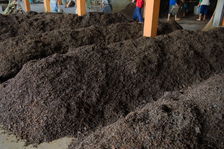
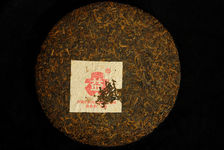
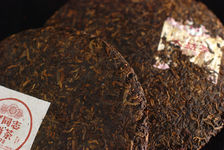
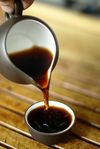
- 1.Production du shu cha
- 2.Galette de puerh (Pu Er tea) fermenté
- 3.Deux puerh (Pu Er tea) fermentés
- 4.Liqueur de shu cha
Initially the Shu Cha were intended to imitate the traditional Hong-Kong refineries (see lower ) in a faster, industrial and controlled manner. This type of puerh, however, has changed enormously since it first appeared in the 1970s, and since the 2000s, the contemporary shu cha have become a puerh (Pu Er tea) family in its own right, which does not refer gustatively to Old puerh, nor to Hong Kong storage.
This type of puerh (Pu Er tea) has since its beginnings been thought for export, especially in Europe and even in France (with these famous Teutocha of Yunnan, produced by Xiaguan!). It is therefore consumed very little in Yunnan and is therefore found more in northern China, Hong Kong, or other countries, especially Russia and Eastern Europe where it is highly valued .
Whereas the first shu cha were weakly fermented and possessed a very good guarding potential, the shu cha produced today are above all immediate consumer products with a very high fermentation rate and an excessively reduced conservation potential.
Generally, the Shu Cha anterior to the mid 90s still possess a moderate fermentation, and leave an important part to natural maturation. Some of these ancient shu cha have also undergone a second ripening in Hong Kong, giving them a touch of old typical tea, and a different taste character of shu cha stored in natural way.
Finally the older shu cha (70s, 80s), slightly fermented in their production and then worked by time, can recall old sheng (raw puerh) refined in Hong Kong.
Taste character
The fermented puerh (Pu Er tea) are very round teas, with bitterness and astringency non-existent or almost. They develop a dark and thick liquor and warm, woody aromas, sometimes in fruit or dry fruit, or in touches of undergrowth (mushrooms, moss, earth, lichen).
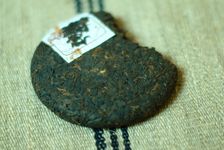
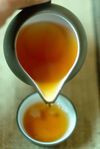
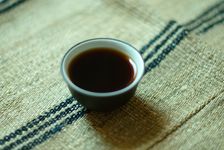
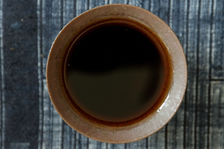
- 1.Galette de shu cha
- 2.Liqueur d'un shu cha faiblement fermenté
- 3.Liqueur d'un shu cha fortement fermenté
- 4.Liqueur d'un shu cha ancien
The young fermented puerh (Pu Er tea) quality produce in general a very smooth liquor, and pure and brilliant aromas. When they are older (70's, 80's), or they have gone through a second ripening in Hong Kong, they will find a bigger grain and keys reminiscent of the undergrowth or old puerh.
Contrary to what is sometimes heard, shu cha, especially today, are not characterized by aromas of mold, wet cellar or fish. Such unpleasant touches are found in poor quality teas resulting from poor fermentation or inadequate storage. These teas should be avoided and are in no way representative of this family of tea.
Most of this puerh (Pu Er tea) family
- Shu cha products today are designed for immediate consumption and can be consumed as soon as they are produced. These young shu cha are commonly used industrial products, not tasting teas, and are therefore very cheap.
- Ancient shu cha, or refined in Hong Kong, are naturally more expensive than young shu cha but are much cheaper than the old puerh (Pu Er tea) greens, and allow to learn the character of old puerh (Pu Er tea) at lesser prices.
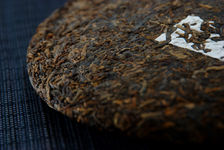
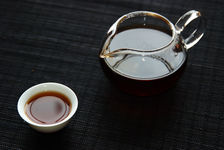
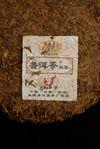
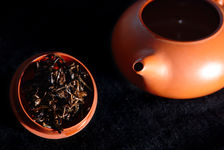
- 1.Shu cha début 2000
- 2.Dégustation d'un shu cha en gong fu cha
- 3.Galette de shu cha pur bourgeon
- 4.Dégustation d'un shu cha en gong fu cha
- Fermented puerh (Pu Er tea) allow a large number of successive infusions. Moreover, the absence of bitterness makes them accessible to sensitive palates and allows their infusion as well in gong fu cha as in a big teapot.
- Contemporary shu cha offers a wide variety of aromas. According to the growers, the size of the leaves or the level of fermentation, they will produce very different characters with aromas that can touch wood, fungus, hazelnuts or even cherry!
- Fermented puerh (Pu Er tea) do not lose their richness over time, and can easily be kept in contact with air for very long periods. Some shu cha, when slightly fermented, possess the ability to evolve over time in the manner of a raw purh or a refined tea in Hong Kong and can constitute good guard teas.
The least of this puerh (Pu Er tea) family
- Shu cha are cheap and industrial products, and are generally produced from low quality leaves (low seasons, intensive cultivation, etc.), and do not have the wealth of finer harvests.
- Shu cha are mainly produced today for daily consumption, not as teas for tasting, and therefore naturally lack the richness and complexity of large teas.
- Contemporary shu cha, which is highly fermented, has a very limited maturation potential.
How to choose a shu cha
Shu cha are teas that have been heavily fermented in their production, and then sometimes refined to give them some aromatic touches. They do not require custody and can be eaten immediately, which makes their choice quite simple:just taste several teas (either at the seller's where possible or by buying a small amount) and then choose Those whose character is most agreeable to you.
There is a great variety of characters within this puerh (Pu Er tea) family:
The size of the leaves (grade) has a strong influence on the character of this type of fermented puerh. Large leaves (high grades) are generally less fermented and have a tendency to develop finer, light, subtle, and more influenced by aging. On the contrary the buds and the fine grades will give shu cha heavier, thick and thick.
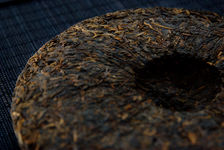
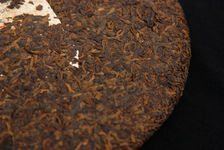
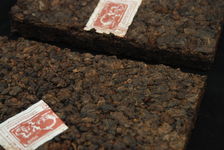
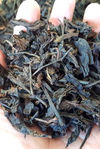
- 1.Assemblage de grade variés
- 2.Shu cha de grade fin ou gong ting
- 3.Amat de shu cha ou cha tou
- 4.Shu cha de grade élevé ou Da Ye
The contemporary shu cha products from the 2000s onwards are generally brighter, smooth, pure and luminous. The character of such teas comes mainly from the parameters of their fermentation, a great variety of taste will be found according to the producers, but also from one lot to another, with teas denser and thick, others lighter, and Very varied aromas that can refer to wood, dried fruits, or spices.
The older shu cha, produced before 2000, are generally less fermented, cooler and subtle, with sometimes suspicions of tannins that can be reminiscent of old sheng cha and marks of maturation that refer to old puerh (Pu Er tea) or refined teas in Hong- Kong. They are thus less smooth at the palate and develop larger, slightly powdery grain, which differs from the silky texture of contemporary shu cha. Unlike the latter, the shu cha of the past also leave more room for natural maturation and continue to be done over time, especially if they are the fruit of a light fermentation.
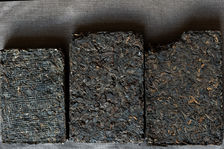
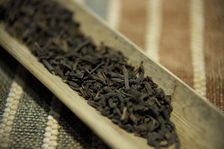
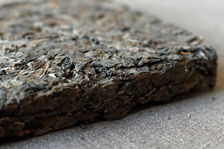
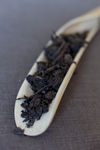
- 1.Trois shu cha vieillits
- 2.Shu cha affiné des années 90
- 3.Shu cha des années 70
- 4.Shu cha affiné 40 ans d'âge
Some shu cha, especially old ones, have also undergone a second ripening called "traditional Hong Kong storage" or "wet storage" (see below ). When it is of poor quality such ripening gives the tea unpleasant touches of mold or wet cellar, and such teas should be avoided. On the contrary, a quality Hong Kong traditional storage will play a very pleasant way on the texture and the character of the shu cha, bringing it a mellow characteristic, more depth, and aromatic touches that can recall old puerh.
Tasting of two shu cha
To illustrate this I propose you the tasting of two shu cha of nature and character very different. The first is a very affordable shu cha with a very contemporary character, produced in 2013 in the Yong De area. The second is a shu cha of very high quality, produced in the 70s and then refined in Hong Kong.
 Chargement du thé...
Chargement du thé... Chargement du thé...
Chargement du thé...The old puerh (Pu Er tea)
The universe of old teas is by far the noblest and richest of the large family of puerh (Pu Er tea) tea. It is a special field that concerns exclusively teas that are at least fifty years old. Indeed, although twenty or thirty years may seem like a long period of time, and sometimes ten years old teas sold (especially in Yunnan) sold as "old puerh", teas of this age can not be considered As such, for the simple reason that they are far from having attained the characteristic taste of the old puerh. This type of puerh, has long been appreciated in Hong Kong, Malaysia and Taiwan.
After about fifty years of maturation, puerh (Pu Er tea) teas (when they have good custody potential), as well as some other dark teas (Liu Bao, Liu An, etc.) arrive at their peak. They develop a typical character and particularly appreciable, but also a wealth and depth out of the common. It is the re-discovery of these old teas, enjoyed in Hong Kong for a long time, propelled the puerh (Pu Er tea) to the forefront in the 1990s, boosting the puerh (Pu Er tea) youth market in Yunnan.
The old puerh, when they are of quality, are a true masterpiece, and their tasting are privileged moments that exceeds what is generally heard by the tasting of a tea. In addition to the exceptional taste of some old puerh, we also particularly appreciate the deep and relaxing effect that their tasting causes ( Cha Qi ).
Taste character
The old puerh (Pu Er tea) of quality are of an exceptional richness and depth. The Yin Ji Cha (years 50-60) are considered to reach today at their peak, with unrivaled power and depth. The Hao Ji Cha, produced between the 1900s and the 1950s are on the decent, and are therefore a little less intense but possess complexity, finesse and an incredible charm.
In both cases one is faced with exceptional teas, of a fabulous taste quality and whose character and aromas are the fruit of more than 50 years of slow transformation. The initial aroma of the tea then completely disappeared to leave room for an alchemy of a very complexity that time has very gradually put in place. The result is a unique character that does not refer to any other tea family and possesses an intensity and an exceptional depth.
The coolest old puerhs will still display camphorated notes, while the most melted teas express themselves more roundly in an indescribable alchemy of woods, dried fruits and a multitude of small notes as sharp as ephemeral.
The great old puerh (Pu Er tea) (Red mark, Song Pin, Tong Ching, etc.) also have an extraordinary endurance and sometimes support more than one hundred infusions. Beyond their gustatory character, what we like about old teas is also, and sometimes above all, their cha qi , an intense and profound feeling of appeasement, of drunkenness, that their Consumption which is not found in any other tea.
Most of this puerh (Pu Er tea) family
- The old teas have already reached their peak. They are therefore consumable immediately and do not require custody.
- These teas offer unrivaled richness, depth and complexity.
- The tasting of such teas provokes soothing, exhilarating, truly exceptional sensations that are not found in any other tea.
- The endurance of these teas is sometimes impressive, allowing for some teas more than 100 successive infusions over several days!
The least of this puerh (Pu Er tea) family
- The old puerh (Pu Er tea) are rare and today hard to find. If they offer an unusual experience, they are now particularly expensive, from a few thousand euros to the cheapest cake (Guangyun gong, etc.) to several thousand euros tasting for the more expensive (Red Mark, Hao Ji Cha, etc.), which makes them impractical.
- At the price of these teas it is generally not possible to taste the cakes before their purchase, and very difficult to buy only a small amount. Moreover counterfeits are very common, representing the majority of what is found on the market, and knowing how to distinguish authentic old puerh (Pu Er tea) copies requires a serious experience in the field.
How to choose an old puerh (Pu Er tea)
Choosing and buying an old puerh (Pu Er tea) requires some experience. It is strongly advised not to go into the purchase of such teas if you do not have a thorough knowledge of ancient teas, and it is better to have you assisted by a specialist.
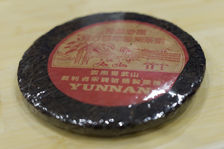
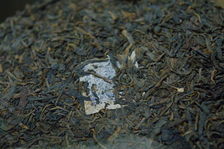
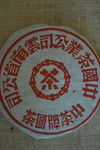
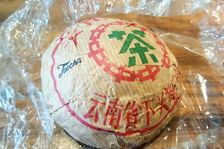
- 1.Contrefaçon grossière de Song Pin Hao
- 2.Contrefaçon de Song Pin Hao
- 3.Contrefaçon grossière de Marque Rouge
- 4.Contrefaçon de vieux tuo cha
Counterfeiting has always been very common, even among renowned sellers (who often bought these counterfeits without their knowledge in the 1990s), and it is therefore necessary to ensure the authenticity of the tea before the " buy.
Auctions, when supported by serious experts, sometimes provide a certain guarantee on the quality and authenticity of the tea, but at prices generally above market prices and what direct purchase from Of private collectors allows.
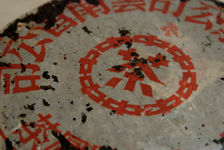
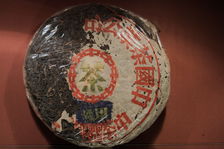
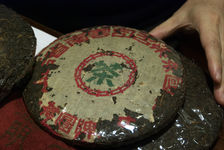
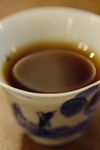
- 1.Marque rouge années 1950
- 2.Marque bleue années 1950
- 3.Marque verte fonte artistique années 1950
- 4.Infusion de Marque rouge années 1950
Yin Ji Cha, and in particular the Red Marks of the 50s, are generally regarded as safe values, which reached their peak, although there were large differences of quality in these teas according to the period And the quality of its storage.
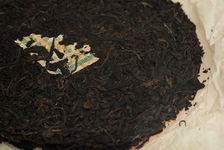
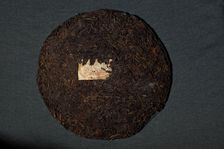
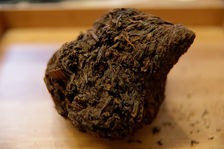
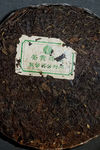
- 1.Tong Chang Hao années 1940
- 2.Tong Qing Hao années 1940
- 3.Jincha années 1910
- 4.Fu Lu Gong Cha années 1940
The Hao Ji Cha, or antique teas, produced before the 1950s are real jewels, less intense but more subtle and delicate than the teas produced later. The teas of this period, produced by small private workshops, are particularly marked by the know-how and personality of each producer. There are thus great differences of character and quality according to each family of producer, and sometimes the period of production. It is therefore advisable to know these different characters and to be on the one that suits you before investing in an antique cake.
There are also old puerh, produced in the 1960s, for example, which are less recognized and more accessible than large historical teas, such as good series of Guang Yun Gong (Guangdong), or good Liao Fu San Cha Viet-Nam) in bulk. Without reaching the excellence of the great patties of the same years (Red mark, blue mark, etc.), these puerh (Pu Er tea) are sometimes of very high quality, and allow to lower prices in the universe and the typical aromas of old teas.
Naturally, it is also appropriate for these teas to be wary of counterfeits, and generally of so-called ancient teas and sold at too good a price, especially in bulk. Whenever possible, and especially for bulk teas, it is highly advisable to taste the tea to judge its quality, age, quality or and storage, or to be made to assist by one. Specialist, before buying in quantity!
Tasting of two old puerh (Pu Er tea)
To illustrate this fantastic family of teas puerh, I propose you the tasting of two very large teas. The first, Guangyun gong (authenticated by Mr. Teng Shih Hai), is a series released in the 60s and recognized for its quality among the puerh (Pu Er tea) produced in Guangdong. This is part of the teas recognized by the lovers of old puerh (Pu Er tea) for its high quality, while remaining relatively affordable. The second, Song Pin Hao, is one of the greatest puerhs in history, to which I devoted a complete article, produced to Yi Wu in the 1910s.
 Chargement du thé...
Chargement du thé... Chargement du thé...
Chargement du thé...Traditional Hong Kong storage, or puerh (Pu Er tea) refined
The traditional Hong Kong storage or refining Hong Kong, sometimes also referred to as warehouse storage (as opposed to storage at home) or wet storage (as opposed to natural storage) is a slow and controlled method of controlled ripening of tea Puerh practice in the Hong Kong area. Traditionally these teas are puerh (Pu Er tea) sheng, that is to say green puerh (Pu Er tea) at the time of their production, slowly fermented artisanally in Hong Kong (or elsewhere with the same methods). Sometimes it can also be shu cha, that is to say teas already fermented in Yunnan, and which will then undergo a second fermentation in order to obtain the desired taste character.
Traditional Hong Kong storage consists in influencing the maturation of the tea to obtain the desired flavor and texture (playing the "Hong taste"), playing on the storage conditions and in particular the humidity and aeration of the storage space -Kongais "). Such ripening, when of poor quality, gives the tea unpleasant touches of mold or damp cellar. Such teas must absolutely be avoided and in no way represent this mode of ripening. On the contrary, a well-kept traditional Hong Kong storage allows the production of pure teas of very high quality, which will be particularly appreciated as much for their texture in the mouth as for their specific flavors
The vast majority of the puerh (Pu Er tea) teas from the pre-2000 market are traditional Hong Kong storerooms (whether they say it or not). This type of puerh (Pu Er tea) is particularly appreciated in Hong Kong, in the Guangdong region, but also in Taiwan or Malaysia.



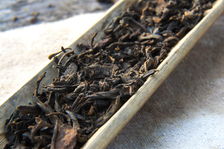
- 1.Entrepot à Hong Kong
- 2.Stock de thé à Hong Kong
- 3.Pièce humide d affinage du thé
- 4.Puerh années 1990 affiné à Hong Kong
A good traditional Hong Kong storage requires a lot of know-how and a minimum of ten to twenty years of maturation. When this maturation is perfectly controlled, the teas produced can be close to the taste of old puerh, 50 years and more.
The prices of the old puerh (Pu Er tea) (produced before the 70s) have in recent years reached the peaks, making these ancient teas less and less accessible. Traditional Hong Kong stalls, which play on the same gustatory register and are much cheaper, have now become an affordable way to learn about the world of old teas and appreciate the typical aromas of post- fermentation.
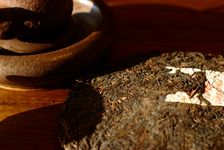
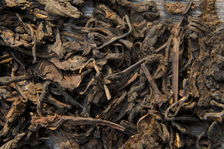
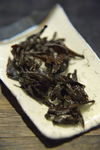
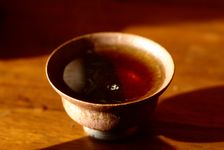
- 1.Galette 1997 affinée à Hong Kong
- 2.Thé en vrac années 90 affiné à Hong Kong
- 3.Puerh affiné à Hong Kong feuilles infusées
- 4.Liqueur d'un puerh (Pu Er tea) affiné à Hong Kong
Shu cha lovers, who are the industrialized and fast-paced Hong Kong storage, will also see Hong Kong's refined teas as a slow, craft-like form of "super shu cha", and new horizons to explore .
Taste character
Traditional Hong Kong storage is traditionally finely fermented raw puerh (Pu Er tea) (green), but some shu cha (fermented to their production in Yunnan) can also be passed through this type of maturation to give them a touch of old teas and a mellow specific).
These teas play, in the manner of old puerh, on the post-fermentation aromas typical of puerh (Pu Er tea) tea. They will present different characters depending on the level of this fermentation and the age of the tea. With a light fermentation we will obtain fresh teas, which will develop a mineral and wooded dimensions, with touches of camphor wood and eucalyptus. When the fermentation is more intense or the tea is older, much darker teas will be obtained, with warm, round characters in which one can find a woody reminiscent of old puerh (Pu Er tea) or gourmet notes of almonds, walnuts Or dried fruit.
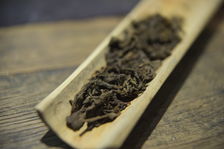
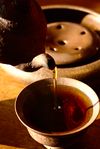
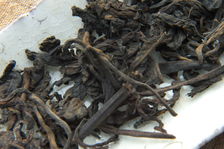
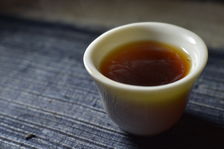
- 1.Vrac années 1990 affiné à Hong Kong
- 2.Liqueur d'un puerh (Pu Er tea) affiné à Hong Kong
- 3.Puerh fermenté des années 1990
- 4.Liqueur d'un puerh (Pu Er tea) affiné à Hong Kong
A good traditional Hong Kong storage is also characterized by the mouthfeel that it provides and its round and soft texture, which are elements at the heart of the Hong Kong taste. Their grain in the mouth will vary according to the level of fermentation, between something slightly rough with the presence of tannins still partially sharpened for the less fermented teas, to something completely melted and silky for the more fermented teas.
Some teas refined in Hong Kong also develop magnificent cha qi , this deeply soothing sensation typical of aged puerh.
Most of this puerh (Pu Er tea) family
- Quality traditional Hong Kong storage should only be removed from the stock once it has reached maturation and satisfactory quality, usually after at least 10 to 15 years of ripening. These are therefore already refined teas and can be consumed immediately after purchase.
- This family of puerh, based on the know-how of refining and a slow post-fermentation, offers a wide variety of characters depending on the tea, leaf size, degree of fermentation, Approach to each house responsible for ripening.
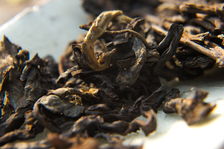
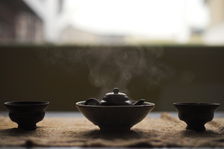
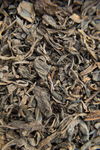
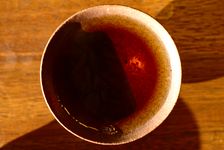
- 1.Puerh affiné à Hong Kong années 1990
- 2.Dégustation d'un puerh (Pu Er tea) affiné
- 3.Puerh affiné à Hong Kong
- 4.Liqueur d'un puerh (Pu Er tea) affiné
- For fans of old puerh (Pu Er tea) (50 years and older), Hong Kong refineries offer an alternative to a much more reasonable price. Traditional Hong Kong storage makes it possible, with a maturation of only twenty years, to obtain taste characteristics close to teas of more than 50 years. If they do not possess the richness and depth of these great ancient teas, they allow to savor the uniqueness of time, which has made the renowned puerh (Pu Er tea) teas.
- For Hong-Kong puerh (Pu Er tea) lovers (traditional shu cha), traditional Hong Kong storage also offers a richer, subtle, complex and varied alternative to shu cha produced in China today.
- A number of traditional Hong Kong storage facilities are loose, have never been compressed, have been delivered in bulk before or after ripening. This type of tea is generally much cheaper than teas of the same age in cake or brick.
- Traditional Hong Kong teas, especially the least fermented, continue to age, and can therefore be a good tea for custody. The best example of this is the famous red marks (Hong Yin in Chinese or Red Mark in English), a particularly renowned 50s tea, the vast majority of which have been refined in Hong Kong to become over the years a genuine chef 'artwork.
The least of this puerh (Pu Er tea) family
- Although traditional Hong Kong storerooms are close to the taste of old puerh, they do not have the finesse, subtlety and legendary depth.
- Some puerh (Pu Er tea) from traditional Hong Kong storage may have typical and unpleasant mildew and wet cellar flavors, where the ripening has not been done with enough care or is not completed.
How to choose a puerh (Pu Er tea) refined in Hong Kong
Many teas sold as traditional Hong Kong storage, wet storage, or simply as old tea, come from poor quality or unfinished storage, and exhibit aromas of damp, unpleasant mold. If moisture comes into play in a Hong Kong maturation (hence the name of wet storage), it must be controlled and in no way roughly tincture the end result.
It is therefore advisable in the first place to make sure, when tasting tea, that the latter is "clean" and presents no unpleasant trace to the palate. If these teas can develop pleasant aromas of fungus, lichen, tree moss or forest, they must not under any circumstances feel the mold or the wet cellar.
Good transitional storage in Hong Kong is the fruit of slow and delicate fermentation (as opposed to shu cha, which is fermented very quickly), and therefore continues to evolve over time. The choice of a traditional Hong Kong storage will therefore depend on what one will look for:a tea to be consumed immediately, or a tea to keep aging.
For a tea to be consumed immediately, one can rely on one's personal tastes and be satisfied with tasting the tea to get an idea. According to the tastes we prefer weakly fermented teas, with still a certain dose of tannins and camphorated flavors, or teas more worked by maturation, darker more mellow and melted. Teas refined in Hong Kong with a very wide aromatic variety, with very different degrees of maturation, it is advisable to start by making the palate, tasting or buying in small quantity teas of age, Origin and different characters to identify the flavors that suit you most.
For a tea of guard, one will prefer a teas presenting a light or average post-fermentation, rich in taste and aromas, and whose tannins have not been entirely melted by the maturation. As with the purchase of a young guard puerh, it is recommended to have a certain knowledge in the puerh (Pu Er tea) and its maturation before buying a tea in large quantity as seen from its storage.
The character of a traditional Hong Kong storage comes in large part from the way it has been refined. The degree of maturation, and the impression of the old tea, therefore depends chiefly on the conditions of this maturation, and not on the true age of the tea. This should be borne in mind when choosing a refined tea in Hong Kong, and relying primarily on tasting, not on the vintage. For example, a 1998 tea with a deep maturation may be much more melted and look older than a 10-year-old tea if it has been weakly fermented.
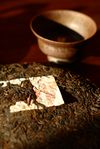
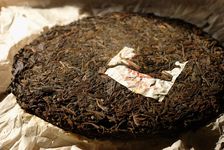
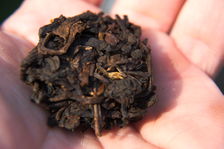
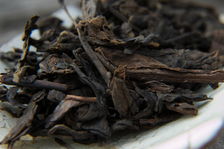
- 1.Galette affinée à Hong Kong
- 3.Fragment de galette remis en vrac
- 4.Stockage Hong Kongais vendu en vrac
The traditional puerh (Pu Er tea) storage Hong Kong exist in slab or bulk. The latter, never compressed or handed in bulk, are generally much cheaper than their compressed ones and are therefore an excellent choice for those who discover this tea family or who seek above all in tea its taste quality. On the contrary, the cakes, when they are authentic, bring more traceability and add a cultural dimension by allowing the initiation of the characteristics of this or that region, producer, or period.
Tasting of two puerh (Pu Er tea) refined in Hong Kong
To illustrate this I offer you the tasting of two puerh (Pu Er tea) from good traditional Hong-Kong storage. The first is a tea of 2002, weakly fermented, which still has a certain freshness and marked camphoric touches. The second is a 1998 tea with much deeper fermentation, which appears to be much more melted, and is close to the taste of old puerh.
 Chargement du thé...
Chargement du thé... Chargement du thé...
Chargement du thé...
